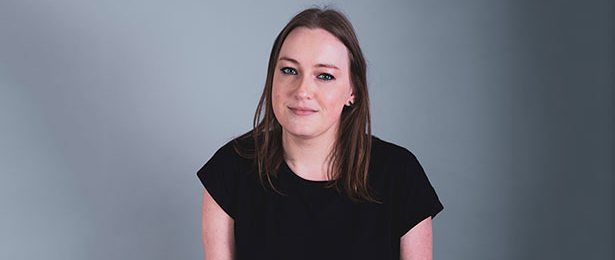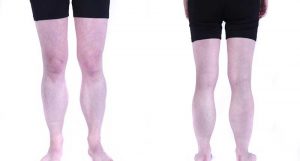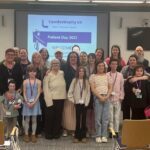
Living with Lipodystrophy | Becky Smith
Posted Sunday 14th Aug 2022 Patient Stories
Today we speak with Becky, who has Familial Partial Lipodystrophy. Becky shares her experience of how she was diagnosed and what it is like living with Lipodystrophy.
Can you tell us a bit about you?
My name is Becky. I am 33 years old, originally from west London but will be relocating to North Yorkshire soon. I work full-time as a web developer. I enjoy travelling, doing crafts, playing video games, listening to music and spending time with my family and friends.

How were you diagnosed with Lipodystrophy?
Unbeknown to my family, I was born with Familial Partial Lipodystrophy type 3. As a child, I appeared no different from my friends or family without Lipodystrophy. The only notable issue in my childhood was the occasional, crippling cramps in my calf muscles. After the pain subsided, I would walk with a limp for an hour or so until my muscles had stretched back out. I also went through a period where I would faint, particularly in hot weather.
Noticeable differences began to emerge during my teenage years. One of the first things everyone noticed was my muscular calves and broad shoulders. This was also when I first began experiencing regular fatigue, often needing afternoon naps to get through the day. At 16, during a routine doctor’s appointment, it was discovered that I had high blood pressure. At the time, this was wrongly attributed to ‘white coat hypertension’.
By my early twenties, the fatigue had intensified. I had an office job and would often struggle with extreme tiredness while sitting at my desk, needing to get up, walk around or splash my face with cold water to continue. After a couple of years, I visited my GP. Tests revealed I was prediabetic. I was confused, as I was young and not overweight. My father, who I later realised also had Lipodystrophy, had diabetes and had passed away when I was 18. Due to my negative associations with diabetes, I struggled to accept the diagnosis and did not make lifestyle changes at that time.
In my late twenties, I felt progressively worse. At 27, I was finally prescribed medication for high blood pressure after it was found to be severely elevated during a hospital visit. I knew something was seriously wrong, though it was difficult to explain what I felt as the symptoms were invisible.
A year later, aged 28, I noticed unusual spots appearing on my body. My GP, unfamiliar with this presentation, initially assumed it was folliculitis and prescribed antibiotics. Routine blood tests were also taken. That evening, a healthcare professional from the lab called to tell me I needed to go to hospital immediately due to extremely high triglycerides, placing me at high risk of pancreatitis. Scared and confused, I went to the hospital, marking the beginning of my Lipodystrophy diagnosis.

Image of the Eruptive Xanthomas Becky experienced
After a four-day hospital stay, I was discharged with multiple medications. I had been diagnosed with diabetes, high triglycerides, high cholesterol and fatty liver. The spots I developed were called eruptive xanthomas, resulting from the high triglycerides circulating in my blood. I was fortunate not to have developed pancreatitis despite triglyceride levels reaching 67mmol/l (normal range: below 1.7mmol/l).
Due to the severity of my condition at a young age, I was referred to a specialist diabetic clinic for rare forms of diabetes. The healthcare professionals there were familiar with Lipodystrophy. Following a body assessment, they suspected I had Lipodystrophy and arranged genetic testing. The results confirmed Familial Partial Lipodystrophy type 3, inherited from one of my parents. We suspected my father, who had diabetes, high blood pressure, high cholesterol, and sadly passed away following several strokes and heart attacks.
How did being diagnosed with Lipodystrophy make you feel?
I remember receiving a call from a consultant at the specialist clinic informing me that my genetic test results confirmed Lipodystrophy. She explained my condition and type. Immediately afterwards, I searched Lipodystrophy online and was disheartened to learn there is no cure and that it is a lifelong condition.
I found it difficult to accept the diagnosis. I felt alienated and different from those around me who did not have a rare condition. Thoughts about my father and the likely impact of Lipodystrophy on him were distressing, particularly remembering the strokes and heart attacks he suffered.
Over time, this led to feelings of depersonalisation, severe health anxiety and panic attacks, where I would worry excessively about my health.
What impact does Lipodystrophy have on you physically, emotionally and mentally?
Physically, I experience aches and pains, muscle fatigue and cramping, especially during physical activity. My calves still cramp occasionally, though less frequently than in childhood.
Emotionally and mentally, Lipodystrophy has a significant impact. Managing a strict low-fat and reduced-carbohydrate diet alongside regular exercise is essential for my health. I experience cycles of acceptance and hope, where I maintain my diet, exercise and work commitments. However, fatigue often disrupts this balance. When my diet or exercise slips, my health indicators, such as blood sugar, cholesterol and triglycerides, worsen, leading to self-criticism and low mood. Balancing work, social life and health management can be challenging and affects my self-esteem.

Becky’s calves
I also experience self-consciousness about my appearance. For example, I avoid wearing knee-length skirts without boots due to comments about my legs and am mindful of my double chin, which is larger than normal due to lipodystrophy. Social situations, such as events with photographs, can feel uncomfortable.
How do you manage all of your conditions? What are your biggest challenges?
Following a strict diet generally keeps my conditions (blood pressure, cholesterol, triglycerides, fatty liver disease and diabetes) under control. At one point, I was able to normalise my diabetes levels and reduce my fatty liver, although maintaining this consistently is challenging.
My biggest challenge is sustaining a strict lifestyle alongside a full-time job and managing the emotional and mental burden of Lipodystrophy. At times, managing the disease itself feels like an additional job.
When I achieve a good balance with diet, lifestyle and work, I feel in control of my condition, which fosters hope and positivity for the future.
For anyone newly diagnosed with Lipodystrophy, what advice would you give them?
Allow yourself time to accept and come to terms with your diagnosis. Feeling scared, upset or experiencing other negative emotions is normal. Seek psychological support and surround yourself with positive, supportive friends and family. Talking about your feelings is important.
I also recommend learning about Lipodystrophy and focusing on aspects you can control. Managing associated conditions through lifestyle, diet and prescribed medication can be empowering and instil hope. Setting goals and achieving them helps with day-to-day coping. Lipodystrophy does not have to define you.
Created by: Rebecca Sanders
Blood pressure Cholesterol Fatty liver Patient story Triglycerides







